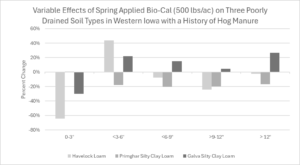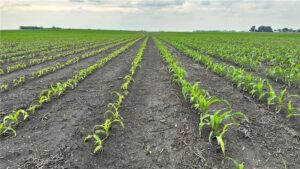Bio-Cal® Trial Shows Compaction Reduction in Iowa Loams

This study evaluated the impact of a one-time Bio-Cal application (500 lbs/acre) on soil compaction across three poorly drained Iowa soil types with long-term hog manure use: Havelock Loam, Primghar Silty Clay Loam, and Galva Silty Clay Loam. The results demonstrate Bio-Cal’s targeted potential to improve soil structure and productivity in manured, poorly drained systems.
Havelock Loam, a somewhat poorly drained loam, showed the greatest reduction in topsoil compaction (up to 65%) in the 0–3” zone. This indicates a strong fit for Bio-Cal in surface-compacted fields, where improved water infiltration, root development, and seedbed conditions are essential for crop performance. Farmers managing loamy soils with history of manure application—especially corn-soybean rotations—can expect noticeable gains in soil tilth and plant emergence with minimal disruption.

Primghar Silty Clay Loam displayed moderate but consistent compaction reduction across soil depths, indicating Bio-Cal’s ability to improve internal soil structure in fine-textured, poorly drained soils. This response suggests Primghar soils—common in northwest and north-central Iowa—are ideal candidates for integrated approaches: Bio-Cal plus deep tillage or drainage enhancement.
Galva Silty Clay Loam, while better drained, exhibited moderate topsoil improvement but increased compaction at deeper layers, likely due to interaction with a naturally dense subsoil or fragipan. This highlights the importance of multi-year or layered approaches (e.g., repeat Bio-Cal, biologicals, or ripping) in Galva-dominant fields across western Iowa and ridge-top landscapes.
Proven Advantages of Bio-Cal
- Quick topsoil improvement in loams and silt loams
- Improves manure-treated soils without disrupting biological activity
- Enhances water movement and seedbed structure in heavy soils
- Cost-effective at 500 lbs/ac with long-term benefits
Target Soil Regions & Best Practices
- Northwest and north-central Iowa: Havelock and Primghar soils with manure history
- Western Iowa ridge systems: Galva soils with dense subsoil layers
- Producers using hog manure and seeking soil structural improvement
- No-till or minimum-till operations facing surface sealing or crusting

